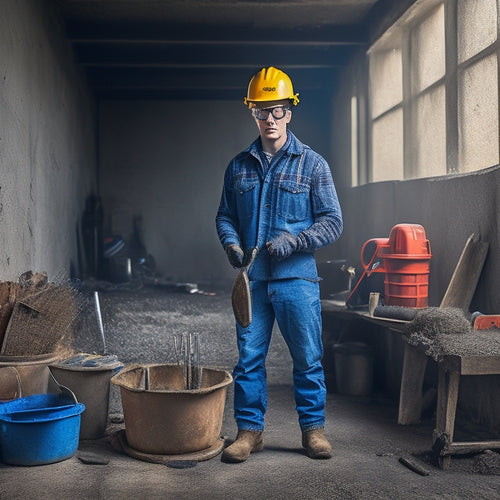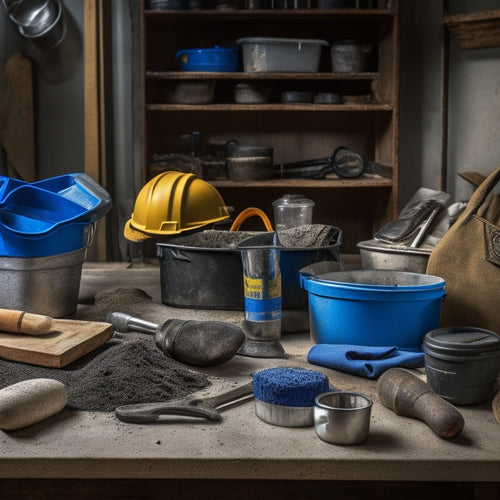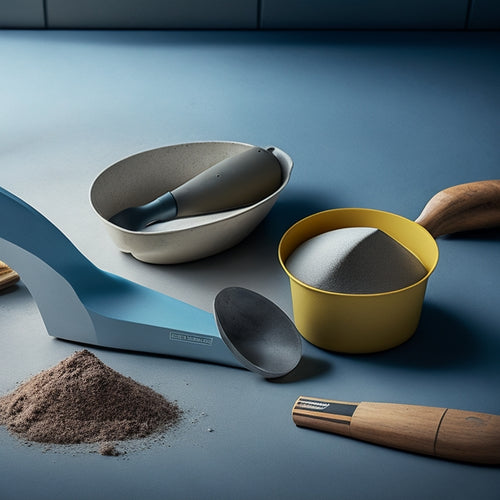
Top Tools for Effective Concrete Wall Cleaning
Share
To effectively clean your concrete walls, you'll need the right tools and techniques. Start with essential brushes, like stiff-bristled brushes for heavy-duty cleaning and soft-bristled brushes for gentle cleaning. A soft-bristle broom is also a must-have for debris removal. For tough stains, power washing with the right nozzle and pressure settings can be effective. Chemical cleaning agents, scrubbers, and safety gear like gloves and eye protection are also vital. By combining these tools and techniques, you can keep your concrete walls looking their best. Now, get ready to take your concrete wall cleaning to the next level.
Key Takeaways
• Use stiff-bristled brushes for removing loose dirt and debris, and soft-bristled brushes for gentle cleaning techniques.
• Employ a soft-bristled broom for sweeping away debris before deep cleaning, using long strokes and focusing on corners and crevices.
• Utilize power washing with a wide fan tip and 12-inch distance from the wall to effectively remove stubborn dirt and grime.
• Choose the right chemical cleaning agent based on the type of stain, and always follow manufacturer instructions and test on a small area first.
• Select the appropriate scrubbing tool, such as wire brushes or abrasive scrubbers, based on the level of buildup and wall texture.
Essential Brushes for Cinder Block
You'll need a few specialized brushes to effectively clean cinder block walls, and the right ones will make all the difference in getting the job done efficiently.
For instance, a stiff-bristled brush is perfect for removing loose dirt and debris, while a soft-bristled brush is better suited for gentle cleaning techniques. When it comes to brush materials, you'll want to opt for high-quality nylon or polypropylene bristles that can withstand the rough texture of cinder block.
When choosing a brush, consider the type of cleaning you'll be doing. For heavy-duty cleaning, a brush with sturdy bristles and a sturdy handle is a must. For lighter cleaning tasks, a smaller brush with softer bristles may be more suitable.
Regardless of the brush you choose, make certain it's specifically designed for cleaning cinder block walls. This will guarantee that you're getting the best possible results and avoiding any damage to the walls.
Power Washing for Tough Stains
When tough stains on your cinder block walls prove resistant to brushing, it's time to bring in the big guns: a power washer. A power washer can blast away stubborn dirt and grime with its high-pressure stream of water.
To get the most out of your power washer, you'll want to use the right power washing techniques. Start by setting the washer to a wide fan tip and keeping it at least 12 inches away from the wall to avoid damaging the surface. Then, work from the bottom up to prevent dirt and grime from running down the wall and settling into crevices.
For particularly tough stains, you can use a narrower fan tip and increase the pressure, but be cautious not to etch the surface. For stain removal tips, try using a wide fan tip to loosen dirt and debris, then switch to a narrower tip to target specific stains.
Remember to always keep the nozzle in motion to avoid creating streaks or marks on the wall. With these power washing techniques and stain removal tips, you'll be able to tackle even the toughest stains on your cinder block walls.
Effective Chemical Cleaning Agents
For especially stubborn stains that resist power washing, turn to effective chemical cleaning agents, which can help break down and dissolve dirt and grime.
When choosing a chemical cleaning agent, consider the type of stain you're dealing with and the chemical properties required to tackle it. For example, oil-based stains may require a solvent-based cleaner, while organic stains may respond better to an acid-based cleaner.
It's also crucial to prioritize eco-friendly solutions that won't harm the environment or compromise the integrity of your concrete wall. Look for products that are biodegradable, non-toxic, and free of harsh chemicals.
Always follow the manufacturer's instructions and take necessary safety precautions when working with chemical cleaning agents.
Remember to test a small area of the wall first to verify the cleaning agent doesn't damage the concrete or affect its color.
Scrubbers for Heavy Buildup Removal
Tough, heavy buildup on your concrete wall requires a more aggressive approach, and that's where scrubbers come in - robust tools designed to tackle even the most stubborn grime and dirt accumulations.
You'll find various scrubber types, including wire brushes, stiff-bristled brooms, and abrasive scrubbers. Each is suited for specific types of buildup and surface textures. When choosing a scrubber, consider the level of grime, the wall's surface, and the level of abrasion needed.
To get the most out of your scrubber, follow some essential maintenance tips. Regularly inspect and clean your scrubber to prevent dirt and debris buildup, which can reduce its effectiveness. Store it in a dry place to prevent rust or corrosion. For wire brushes, use a wire brush cleaner to remove debris and extend its lifespan.
By maintaining your scrubber, you'll guarantee it continues to deliver effective results. Remember to always wear protective gear, including gloves and safety glasses, when using a scrubber to avoid injury.
With the right scrubber and proper maintenance, you'll be able to tackle even the toughest buildup on your concrete wall.
Pressure Washer Nozzle Selection
With your scrubber tackling the heavy buildup, you're now ready to focus on the finer details of concrete wall cleaning. This starts with selecting the right pressure washer nozzle.
You've got options, but choosing the wrong one can lead to subpar results or even damage to the concrete. You'll want to evaluate the type of nozzle you need based on the level of dirt and grime on the wall. For example, a wide fan tip nozzle is great for covering large areas with moderate dirt, while a narrow zero-degree nozzle is better suited for tight spaces with heavy buildup.
Don't forget to adjust your pressure settings accordingly. Higher pressure settings can blast away tough stains, but may damage the concrete or dislodge aggregate. Lower pressure settings are safer, but may not be effective on heavy buildup.
You may need to experiment with different nozzle types and pressure settings to find the perfect combination for your specific concrete wall cleaning job. By selecting the right nozzle and adjusting your pressure settings, you'll be able to tackle even the toughest concrete wall cleaning tasks with ease.
Soft-Bristle Broom for Debris Removal
You'll want to grab a soft-bristle broom to sweep away any loose debris from the concrete wall before moving on to more intense cleaning methods. This essential step guarantees a more effective cleaning process and prevents scratching the surface with harsher tools. The soft-bristle benefits are clear: gentle on the wall, yet tough on debris.
When using a soft-bristle broom for debris removal, keep the following techniques in mind:
-
Sweep in sections, working from top to bottom to prevent dirt and dust from spreading.
-
Use long, smooth strokes to cover more area and pick up debris efficiently.
-
Focus on corners and crevices where debris tends to accumulate.
Safety Gear for Concrete Cleaning
When you're preparing to clean a concrete wall, you're not just grabbing a broom and getting to work - you're also suiting up with the right safety gear to protect yourself from harsh chemicals and rough surfaces.
You'll need to prioritize protective clothing essentials, like long sleeves and pants, to prevent skin irritation.
Additionally, you'll want to take into account eye and face shields, as well as gloves and sturdy footwear, to guarantee you're fully covered from head to toe.
Protective Clothing Essentials
Concrete cleaning can be a hazardous task, so wearing protective clothing essentials, such as gloves, safety glasses, and a face mask, is crucial to safeguard your skin and eyes from harsh chemicals and abrasive particles.
You should prioritize protective clothing materials that are durable, waterproof, and resistant to chemicals. Effective layering techniques can also enhance the protection offered by your gear.
Here are some essential protective clothing items to include in your arsenal:
-
Long-sleeved shirts and pants: Made from breathable, water-resistant materials like polyester or nylon, these will prevent skin exposure to harsh chemicals and abrasive particles.
-
Waterproof boots: With good grip and ankle support, these will keep your feet dry and stable on wet or slippery surfaces.
-
Impervious aprons or coveralls: These will provide an additional layer of protection against chemical splashes and stains.
Eye and Face Shields
As you gear up for concrete cleaning, add an extra layer of protection with eye and face shields that can withstand harsh chemicals and flying debris. These shields are essential for safeguarding your face and eyes from potential hazards. When choosing an eye and face shield, consider the following key features:
| Feature | Description |
|---|---|
| Lens Material | Polycarbonate or Trivex lenses provide superior impact resistance and optical clarity |
| Visibility Enhancement | Anti-fog coatings and scratch-resistant treatments guarantee unobstructed vision |
| Comfort Features | Soft, flexible frames and adjustable headbands promote comfort during extended wear |
| Certification | Look for ANSI Z87.1 compliance to make certain your shield meets industry standards for impact protection |
Gloves and Footwear Needs
Protect your hands and feet from harsh chemicals, abrasive materials, and heavy equipment by investing in the right gloves and footwear designed specifically for concrete cleaning.
You'll be working with strong detergents, scrubbers, and power washers, so it's crucial to have the right protection.
When it comes to gloves, you'll want to choose from various glove types, such as:
-
Chemical-resistant gloves to protect your hands from harsh detergents and solvents.
-
Abrasion-resistant gloves to withstand rough surfaces and scrubbers.
-
Insulated gloves to keep your hands warm and dry in cold or wet conditions.
For footwear, look for materials that are:
-
Slip-resistant to prevent falls on wet or oily surfaces.
-
Chemical-resistant to withstand spills and splashes.
-
Ankle-high to provide additional support and protection.
Broom and Dustpan Combos Work
You'll find that broom and dustpan combos are a simple yet effective tool for removing loose debris from your concrete wall before deeper cleaning. This fundamental step guarantees that dirt and dust don't interfere with your cleaning solution or spread stains further.
When choosing a broom, consider the type of bristles and their stiffness. Soft-bristled brooms are suitable for smooth concrete, while stiffer bristles work better on rough or textured surfaces. You can opt for a push broom, angle broom, or even a whisk broom, depending on the wall's size and your personal preference.
The dustpan design is also essential. Look for one with a rubber or vinyl edge to prevent scratching your concrete wall. A dustpan with a long handle can reduce strain on your back and make it easier to sweep up debris.
Some combos come with a built-in scraper or edge for removing stubborn dirt or stuck-on substances. By investing in a good broom and dustpan combo, you'll be well on your way to a clean and stain-free concrete wall.
Preventing Re-Staining With Sealers
When you've finished cleaning your concrete wall, you'll want to apply a sealer to prevent re-staining.
You'll need to decide on the best application method for your wall, whether it's rolling, brushing, or spraying.
Sealant Application Methods
Applying a concrete sealer correctly is essential to preventing re-staining, as it creates an impermeable barrier between the concrete and potential stains.
When it comes to sealant application methods, you have several options to choose from, depending on the type of sealer you're using and the surface you're working with. You'll want to select the right application technique to guarantee a uniform coat and maximum effectiveness.
Here are a few methods to take into account:
-
Roller application: Use a roller to apply a solvent-based sealer to large areas quickly and evenly.
-
Spray application: Spray a water-based sealer onto the concrete surface, then use a roller or brush to spread it evenly.
-
Brush application: Use a brush to apply a sealer to small, detailed areas or to get into tight spaces.
When choosing a sealant type, think about the level of protection you need, the appearance you want to achieve, and the environmental conditions the concrete will be exposed to.
Preventing Stain Reoccurrence
By using the right sealant and application method, you can effectively prevent stain reoccurrence and maintain a clean, well-protected concrete surface. A high-quality sealant creates an impermeable barrier that repels stains, making future cleaning easier and less frequent. To maximize stain resistance, apply a sealant that's specifically designed for your concrete type and the type of stains you're protecting against.
In addition to sealing, there are other stain resistance strategies you can employ. Regularly cleaning your concrete walls with a gentle cleaner and water can help prevent dirt and grime from building up and causing stains. For high-traffic areas or areas prone to oil or grease stains, consider applying a sacrificial coating that can be easily reapplied as needed.
For long-term maintenance tips, establish a regular cleaning schedule and stick to it. This will help prevent stains from forming and reduce the need for heavy-duty cleaning products. By combining the right sealant with regular cleaning and maintenance, you can enjoy a stain-free concrete surface for years to come.
Frequently Asked Questions
Can I Use Regular Dish Soap for Cleaning Concrete Walls?
You're wondering if you can use regular dish soap for cleaning concrete walls?
While it might seem like a convenient option, dish soap isn't the most effective solution for concrete walls. Its effectiveness is limited, and it can leave residue behind.
Instead, consider alternative cleaning solutions specifically designed for concrete, like a degreaser or a concrete cleaner. These products are formulated to tackle tough grime and stains, giving you better results with less effort.
How Often Should I Clean My Concrete Walls to Maintain Appearance?
You're wise to wonder how often to clean your concrete walls to maintain their appearance.
The key to wall maintenance is establishing a regular cleaning frequency. Aim to clean your walls every 2-3 months, or more often if they're exposed to heavy traffic or harsh weather conditions.
This will help prevent dirt and grime from building up and keep your walls looking their best.
Are All Concrete Walls Suitable for Pressure Washing?
You're about to blast off into the world of pressure washing, but hold on a sec! Not all concrete walls are suitable for pressure washing, just like not all superheroes wear capes.
You need to evaluate the concrete wall materials and pressure washing techniques to avoid damaging your walls. If you've got a wall with a decorative finish or is prone to etching, you'll want to opt for a gentler approach.
Otherwise, you might end up with a wall that's more damaged than dirty.
Can I Use Bleach to Remove Mold and Mildew From Concrete Walls?
When tackling mold and mildew on concrete walls, you might consider using bleach, but beware - it can damage the surface or discolor it.
Instead, opt for bleach alternatives like oxygen-based cleaners or specialized mold removers. These are gentler on the concrete and more effective at removing mold.
To prevent future growth, make sure to dry the wall thoroughly and apply a mold-resistant coating.
Do I Need to Rinse My Concrete Walls After Using Cleaning Agents?
As you emerge victorious from the battle against mold and mildew, remember that the war isn't over yet.
You've conquered the enemy, but now it's time to clean up the aftermath.
When using cleaning agents, you'll need to rinse your concrete walls thoroughly to prevent any residue from causing more harm.
Employ effective rinsing techniques, such as using a pressure washer or a garden hose with a wide fan tip, to guarantee a clean slate.
Conclusion
You've got the tools, now get to work!
Cleaning concrete walls can be a challenging task, but with the right arsenal, you'll be 'cutting through the noise' in no time.
From essential brushes to power washing and effective chemical agents, you're now equipped to tackle even the toughest stains.
Remember to prioritize safety and follow up with sealers to prevent re-staining.
With these top tools and a little elbow grease, your concrete walls will shine like new!
Related Posts
-

What Tools Do I Need for Concrete Wall Repair
As you prepare for a concrete wall repair job, you'll need a variety of tools to guarantee a successful outcome. Star...
-

5 Tools Needed for Quick Fix Concrete Mixing
You'll need five essential tools to tackle a quick fix concrete mixing project efficiently. First, you'll require a s...
-

Ergonomic Concrete Tools for Tight Spaces
When you're tackling concrete work in tight spaces, ergonomic tools are your best bet for comfort and efficiency. The...


